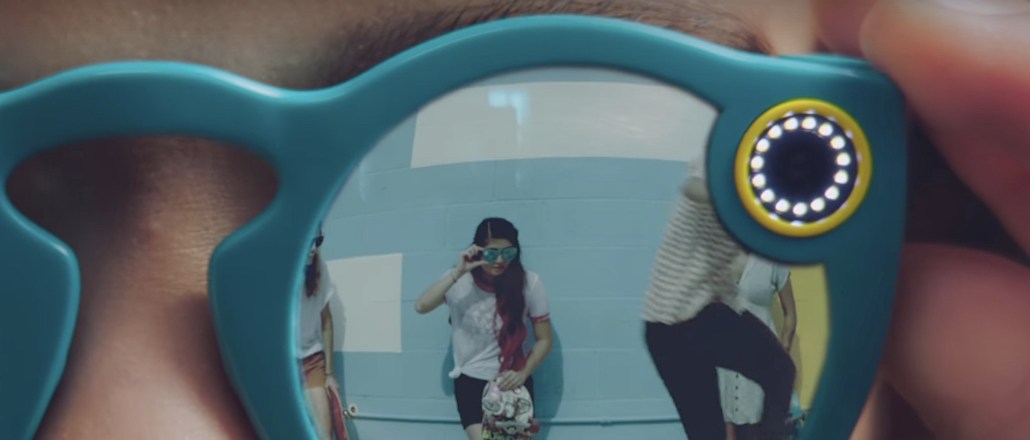
Snapchat just announced a new product that is somewhat less ephemeral than its disappearing photos: This weekend the company surprised observers by revealing it will “soon” be selling its first piece of hardware, Snapchat Spectacles.
The $129.99 glasses allow users to capture videos hands-free. By tapping a button, they can record videos in 10-second bursts. These files are then stored in the Memories section within the Snapchat app.
Snapchat’s typically bright (and youthful) announcement video has already racked up over 1.2 million views on YouTube. But while it came as a surprise for many, there have been hints along the way. The glasses first appeared in grainy paparazzi shots on the head of CEO Evan Spiegel during a holiday with now-fiancé Miranda Kerr.
The Sony hack also revealed Snapchat (now Snap Inc.) had paid $15 million for Vergence Labs, a startup that created cloud-connected eyewear designed to be “cooler” than Google Glass.
Now they are (almost) here, here’s what to know about them:
It learned from Google Glass, but issues linger
There have, inevitably, been comparisons between Snapchat Spectacles and Google Glass, the search giant’s much maligned wearable, which has now been “pivoted” to business users.
Google’s product gained a nerdy reputation after the company distributed early prototypes to Silicon Valley’s elite. The term “glasshole” was deployed to mock users who were seen as half-distracted and promoting tech for tech’s sake.
Snapchat Spectacles have addressed this image problem with style-conscious hires including Lauryn Morris, an eyewear designer who has previously worked with Michael Kors and Nike. Its products, which come in teal, coral and black, look like real glasses too.
“Glass had that middle management robot look, whereas these look friendly,” said Lawrence Weber, Karmarama’s managing partner of innovation. For him, the frames are also less “creepy” than Google Glass, as it’s obvious they are not trying to “masquerade” as a normal pair of glasses.
But while a bright light indicates they are recording, concerns around privacy are likely to remain. Just because people are aware they are being recorded, doesn’t mean they’ll like it. Those who resisted Google Glass because they felt spied-on, will likely have the same concerns here.
It doesn’t really matter if it works
It’s hard for Snapchat to fail here. The company is only releasing a limited run of glasses, with no commitment to make more. While CEO Spiegel’s comments that he is making the product simply for “fun” takes some of the pressure off, too.
The humorless evangelism of Google Glass, and its $1,500 price tag, set it up for a fall. But by managing expectations early on, and committing little, it’s hard for Snapchat to do the same.
The release is a way for the company to gauge interest before it commits. But it’s not just about the tech, but about getting “real estate” in the minds of consumers, according to Rob Scotland, business strategy director at Leo Burnett.
“They continue to be aggressive in what they offer,” he said. “It’s about getting that relevance in people’s minds, capturing moments of their lives.”
It’s banking on a device-less future
Spectacles also speak to a broader trend in consumer tech. “The next user experience is to get rid of user experience,” said Tom Ollerton, innovation director at We Are Social.
While some consumers have an interest in the nitty gritty of technology, many don’t care how their devices works — they only care about the end result. Snapchat’s announcement is another sign that companies are doing away with physical interfaces, whether that’s on a phone or a computer.
The idea is that those who can allow users to behave in a way that feels most natural will win out. This means doing away with swiping, tapping and clicking and introducing voice commands with products like Amazon Echo.
“We’ll eventually have a generation that doesn’t type or drive,” Ollerton said.
It solves the landscape/ portrait challenge
Brands and publishers are only just now wrapping their heads around the challenges of vertical video. “The last thing anybody needs is another video format,” explained David Carr, strategy director at DigitasLBi.
Landscape and vertical video require different skills and kit to get right. However, Snapchat’s built-in camera bypasses this problem altogether: The camera, which is similar to the human eye, has 115-degree-angle lens. This means it can produce circular video instead of the traditional rectangular formats.
“Even if your phone is diagonal you’ve still got a perfect screen of video,” Carr said. Meaning, brands and publishers can sidestep the issue altogether get a consistent standard.
It’s a show for other platforms
Snapchat has made headway in convincing advertisers and publishers it has longevity. The new announcement, and Snapchat’s own name change, show investors the platform can continue to diversify beyond the chat app format, as Facebook did with Oculus Rift.
“It lets people know they aren’t a one trick pony,” said Adrian Lee, digital strategy and innovation director at Vizeum. “But they have credible voice in the other areas of media and tech beyond the chat app space.”
Platforms like Instagram and Twitter have been cloning many of Snapchat’s features, Instagram Stories being the best example. Now, Snapchat is showing its uniqueness once again, even if these glasses do end up as ephemeral as its snaps.
More in Marketing

Starbucks hires first-of-its-kind marketing role heading up fashion and beauty collabs
Neiv Toledano has joined Starbucks as its senior marketing manager of fashion and beauty.

TikTok Shop offers incentives to new sellers, as U.S. uncertainty is finally over
TikTok is jump-starting its e-commerce ambitions in the U.S., now an agreement on the U.S. deal has finally been signed.

How the MAHA movement influenced food and beverage brands in 2025
The MAHA movement has come to stand for different things in different people’s eyes, depending on which initiatives they most closely follow.





